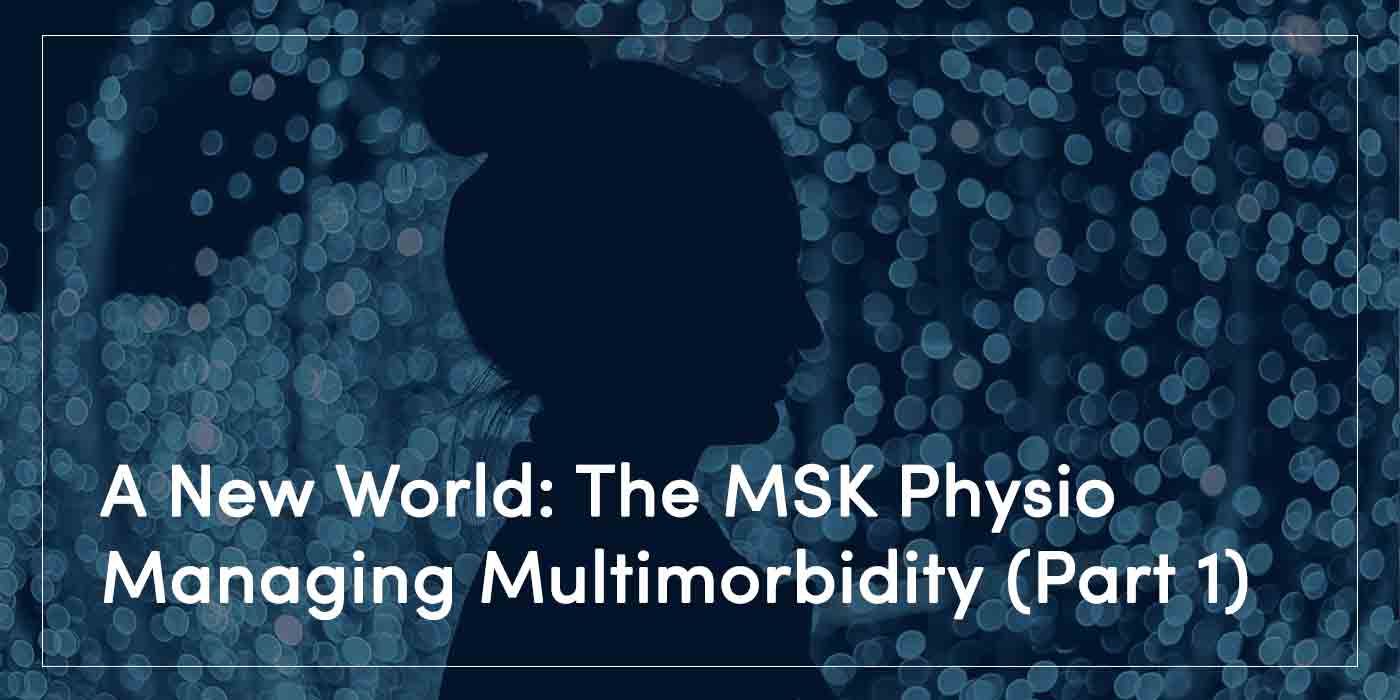A New World: The MSK Physio Managing Multimorbidity

This week’s Clinical Insight is the first in a three-part case study that looks at how we might develop a different model in MSK physiotherapy (as an example in practice) that aligns itself towards a broader health approach to an MSK condition and beyond.
It will also highlight a proposal that suggests that much of what we do should be, and is, across multimorbidity and how extending how we think, rather than what we do, might be the first step.
Patient Case Study
Let’s take an example of a male individual reporting ongoing episodic, but disabling, low back pain without signs of serious pathology and associated leg pain. He also has some non-specific shoulder pain with some loss of movement and a normal X-ray from primary care.
The individual is diabetic, hypertensive, a smoker and has a family history of peripheral vascular disease. There is a history of bouts of anxiety which is managed with medication. The individual is off work.
This individual is under two services already and is now referred to MSK physiotherapy for the low back pain. The physiotherapist takes a careful note of the medical history, then focusses on the low back pain. The focus is on the pain and how to change it, and a range of mobility exercises are given with some advice on why pain stays with you and how doing more might help. The shoulder is not addressed as the referral only mentioned low back pain.
Now, although not particularly amazing physiotherapy, I think it’s fair to say that this would not be unusual?
Joining the Clinical Dots
Perhaps, we look again and join the clinical dots together. The prevalence of MSK pain in patients with diabetes is much higher as compared to pre-diabetic, with knee and shoulder pain being 2 x more likely (Fatemi et al 2015).
Links with hypertension and low back pain have been postulated (Kerkhoff et al 2012), however there are suggestions that hypertension can be related to improved pain perception (Ferreira et al) and so as hypertension is improved, long term MSK pain may become more of a factor.
Pain with hypertension could be due to medication associated with management of this, such as MSK pain being more prevalent in users of statins (Mansi et al 2013). It is well documented that there is a link between depressive symptoms, work absenteeism and MSK pain (Melkevik et al 2018).
What Does this Mean?
So, what does this all mean to the MSK physiotherapist seeing the patient and offering them mobility exercises for their long-term LBP and multiple MSK pain? Firstly, looking across those multimorbidities, the treatment cornerstone of all of these processes is exercise, education and psychologically-supportive practice.
So; in a new world, the MSK physiotherapist is part of a new team.
We stop having complex MSK services and think long term; complexity within the lens of the multimorbidities.
We assess and treat across these multiple systems and the physiotherapist (as an example) uses the skills of activity, psychologically-informed practice and exercise in a multiple modelled way so the patient is managed across their non-medical needs within one service.
One Multi-Professional Service
MSK services become physical activity and lifestyle modification services to serve the needs of a widening population and multimorbidity challenges.
These units are multi-professional and the end goals are shared across this one service so there is no handover. A physician coordinates across the medical needs to ensure patients are safe and linked to their specialist medical teams.
One service, multiple problem management, multidisciplinary approach: one to think about perhaps?
References
Fatemi, A., Iraj, B., Barzanian, J., Maracy, M. and Smiley, A., 2015. Musculoskeletal manifestations in diabetic versus prediabetic patients.
International journal of rheumatic diseases, 18(7), pp.791-799.
Ferreira, S.A., Kokubun, E., Gobbi, S., Fernandes, R.A. and Queiroga, M.R., 2015. Musculoskeletal pain perception and hypertension. Revista Dor, 16, pp.43-47.
Kerkhoff, A.C., Moreira, L.B., Fuchs, F.D. and Fuchs, S.C., 2012. Association between hypertension and musculoskeletal complaints: a population-based study. Journal of Hypertension, 30(11), pp.2112-2117.
Mansi, I., Frei, C.R., Pugh, M.J., Makris, U. and Mortensen, E.M., 2013. Statins and musculoskeletal conditions, arthropathies, and injuries. JAMA internal medicine, 173(14), pp.1318-1326.
Melkevik, O., Clausen, T., Pedersen, J., Garde, A.H., Holtermann, A. and Rugulies, R., 2018. Comorbid symptoms of depression and musculoskeletal pain and risk of long term sickness absence. BMC public health, 18, pp.1-9.
Pescatello, L.S., Franklin, B.A., Fagard, R., Farquhar, W.B., Kelley, G.A. and Ray, C.A., 2004. Exercise and hypertension. Medicine & science in sports & exercise, 36(3), pp.533-553.